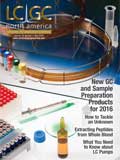How U Is Your UHPLC?
LCGC North America
Tips and tricks to get the most from your UHPLC system
Ultrahigh-pressure liquid chromatography (UHPLC) is a powerful tool for increasing high-performance liquid chromatography (HPLC) sample throughput, chromatographic efficiency, and sensitivity. However, how simple is it to transfer between HPLC and UHPLC applications? There are several parameters associated with both the chromatographic method and the system hardware that need to be considered when switching to UHPLC. This article gives you some practical tips to make sure your UHPLC system is as “U” as possible.
Tips for Reducing System Extracolumn Volume
Extracolumn volume is the total volume contributed by all system components and capillary tubing from sample injection to detection, which are not directly involved with the separation process. Extracolumn volume is the predominant factor in loss of efficiency when using narrow internal diameter columns because of the contribution of peak dispersion; therefore, it is very important to minimize extracolumn volume throughout the system. This can be done by using short lengths of tubing with a reasonable internal diameter.
Peak dispersion is related by the Aris-Taylor equation to flow rate, tubing length, and internal diameter, and the molecular diffusion coefficient of the analyte in the mobile phase, with tubing internal diameter having the greatest impact. Therefore, it would seem that to reduce peak dispersion we should be using the narrowest possible tubing. However, using very narrow tubing comes with a compromise. When tubing internal diameter is decreased, the pressure required to move mobile phase through the tubing increases-for example, plumbing a system with 0.002-in. tubing and running a flow rate of 3 mL/min requires a pressure input of 1500 bar (and this is only to move the mobile phase through the tubing), leaving no pressure capability in the system to be able to install a column and run a separation.
A good compromise between dispersion and pressure is to use 0.005-in. tubing, which at the same flow rate would require a pressure of only 200 bar. It is essential to use the correct column endfittings-ideally zero-dead-volume fittings should be used, with many manufacturers providing specialist UHPLC fittings. Incorrect fittings can lead to leaks or an increase in extracolumn volumes resulting from voids.
If you are using an in-line filter (possibly the most high value piece of the system as they prevent blockages), make sure it has a low dead volume.
Look carefully at the injection system-for example, for a flow-through system look at the apparently small contribution from the needle seat capillary. It is also worth considering the injection volume, which should be matched to the column geometry. A good rule of thumb is to maintain the injected volume at 1–5% of the column dead volume. Most UHPLC experiments are performed with a 50 mm x 2.1 mm column (V0 = 120 µL), so the injected volume should be 1–5 µL to limit peak dispersion.
Tips for Minimizing Frictional Heating
Frictional heating is the viscous heating of the mobile phase as it passes through very small diameter particles, causing a rise in temperature over the column length. Temperature impacts efficiency, retention, and selectivity. Frictional heating effects can be minimized through the use of columns with smaller internal diameters (2 mm is the sweet spot), which are less susceptible to heating and enable more-effective heat dissipation. Column ovens will ensure that the column temperature is accurately controlled. Preheating mobile phases reduces differences in temperature between the inlet and outlet that can cause diffusion of the sample plug, which leads to peak dispersion. Conversely, post-column cooling can be applied to mitigate any peak dispersion. Superficially porous particles also have improved heat dissipation.
Tips for Detecting UHPLC Peaks
Smaller peak volumes and narrower peaks in UHPLC have an impact on both detector hardware and settings. Detector flow cells are often the main source of extracolumn volume; therefore, to minimize this, and in conjunction with the reduction in injection volumes, reduced flow-cell volumes are commonly used (≤2 µL). One compromise of reducing cell volume is the need for a reduction in pathlength, which can have an impact on sensitivity. If greater sensitivity is required, then selecting a larger cell volume and losing some efficiency may be necessary.
It should be noted that if injection volumes are not correctly scaled then overloading of the detector can be encountered. There is also the issue of how the detector acquires the data and reports to the data system. Detector sampling rates (measured in hertz) must be high enough that enough points are detected across the peak to allow proper quantitation. At low sampling rates, peak apices can be missed and numerical integration will be inaccurate. Low data sampling rates alone do not lead to peak broadening, rather a combination of sampling rate and filtering electronics do.
For example, in one system, if the detector is set to acquire data at 40 Hz many data points will be detected across the peak and the data will exhibit a fine structure. Reducing the sampling rate to 1.5 Hz results in fewer data points being detected, which results in a loss of some of the fine structure (for example, the peak apex). An alternative system may exhibit peak broadening when the detector sampling rate is reduced, which can probably be attributed to how the data are handled in the analogue or digital domain inside the instrument module or software.
Get the full tutorial at www.CHROMacademy.com/Essentials (free until June 20).

New Study Investigates Optimizing Extra-Column Band Broadening in Micro-flow Capillary LC
March 12th 2025Shimadzu Corporation and Vrije Universiteit Brussel researchers recently investigated how extra-column band broadening (ECBB) can be optimized in micro-flow capillary liquid chromatography.

.png&w=3840&q=75)

.png&w=3840&q=75)



.png&w=3840&q=75)



.png&w=3840&q=75)






